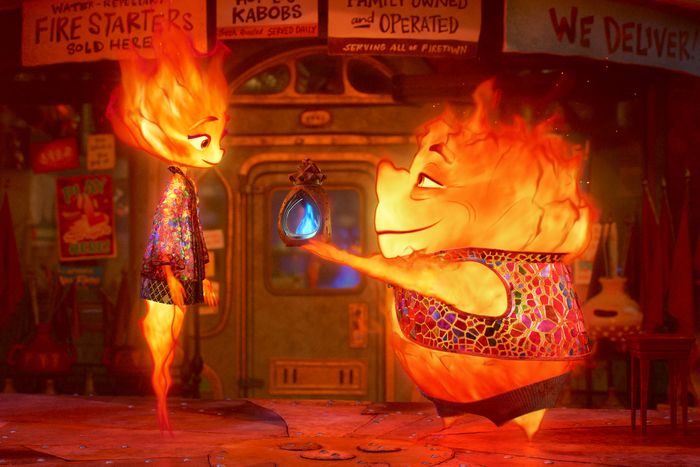
The critical drubbing and box-office floppage of the fire-water rom-com Elemental stood, for the better part of 2023, as one of this year’s most crushing film failures: a two-front defeat all the more curious coming from Pixar, one of filmdom’s most unfailable hit factories. Until the precise moment the opposites-attract animated romp quietly redeemed itself as an under-the-radar triumph after all. To date, Elemental has accumulated nearly $500 million in worldwide ticket sales to become — against almost all expectations — the year’s ninth highest-grossing blockbuster, the most-watched title in Disney+ history, and a frontrunner in the Best Animated Feature Oscar scrum according to reputable gurus of gold.
But that reversal of fortune has been gradual enough — sneaky in a Greatest Showman kind of way, even — to ignore if you weren’t paying attention. (Which, let’s face it, how many people outside the Mouse House C-suite really were?) To the extent that casual moviegoers not possessed of a Disney streaming subscription and a kid under the age of 10 may be aware of it at all, Elemental suffered the ignominy of arriving in theaters in June as the lowest-grossing Pixar title of all time. Costing a reported $200 million to produce, it pulled in a mere $29.6 million over opening weekend to topple the previous title holder, 1995’s Toy Story (which earned $29.1 million in its first three days; adjusted for inflation, a sum closer to $58 million). Worse still for the consistently experimental and technologically innovative animation studio, the reviews for Elemental were decidedly middling to unkind: “dull-witted and syrupy” (Deadline); “the story beats are overly familiar” (Los Angeles Times); “The movie looks good … but its undercooked concept is a problem” (Vulture’s Alison Willmore).
Adding insult to already grievous cinematic injury, industry observers and trade publications were quick to pile on the “Pixar in turmoil” narrative. After an untrammeled, three-decade run pumping out culturally enshrined smash hits including Cars, Coco, Wall-E, and Monsters, Inc., the house that Steve Jobs built had seemingly lost its mojo. During the N95 era, the studio division dumped a trio of well-reviewed features, Turning Red, Soul, and the Call Me by Your Name–esque Luca, straight onto Disney+, a move some industry peers lamented as rewiring viewer expectations in the process. “That’s taught a generation of animated movie-watchers that you can get the best stuff on TV,” an animated film executive at a rival studio complained to me around that time. “It’s going to take another generation to unteach them that. It did a lot of harm to the industry.”
Then came last year’s disastrous Lightyear — a high-concept, Mr. Potato Head– and Woody-less $200 million Toy Story spinoff that grossed just $226 million worldwide to qualify as an implosion on the launch pad. Attempting to turn the page creatively since the 2018 recusal of John Lasseter (the former Walt Disney Animation Studios chief credited with turning Pixar into a commercial powerhouse, who was toppled by allegations of too-touchy workplace behavior), Pixar’s thrice Oscar-sanctified chief creative officer, Pete Docter, faced the perception of a long commercial cold streak on his watch. And, in just the latest manifestation of Hollywood’s “What have you done for me lately?” mentality, rumors of his imminent ouster and of flagging esprit de corps inside studio ranks began to reach beyond the Burbank studio lot. “Morale is low because Pixar’s workers aren’t used to losing,” another animation executive told me on condition of anonymity because the person was not authorized to publicly comment on the matter.
Precisely none of these issues have been lost on Elemental’s director, Peter Sohn. The film took seven years from inception to completion, requiring the efforts of 300-plus people and 150,000 core processors from Pixar’s proprietary “render farm” of supercomputers (by contrast, Finding Nemo and The Incredibles only took 50,000 cores and Toy Story a mere 294). In other words: vast reservoirs of technology and human sweat equity, only to land with a thud at the box office. “I was heartbroken, for sure,” the director tells Vulture over tea in the Hollywood Roosevelt Hotel. “The film just wasn’t connecting. There was a lot of surprise. There were a lot of supportive conversations like, ‘The movie is good. We believe in the work we have done.’ There were also a lot of conversations like, ‘How did we get here?’”
A journeyman Pixar lifer — who has worked as an artist on films including Up, Wall-E, Finding Nemo, and The Incredibles, provided the voices of Emile in Ratatouille and Sox in Lightyear, and wrote and directed 2015’s The Good Dinosaur in addition to supplying creative input to almost every major Pixar project over the last two decades — Sohn conceived the movie as a kind of passion project with direct correlations to his own life. The movie passed Pixar’s green-light process and entered the company’s notoriously iterative production stage with Docter’s explicit blessing to present a more personal vision, somewhat outside the scope of a title like Toy Story, which taps into more universal childhood themes.
Elemental’s central, opposites-attract affaire de fou between Ember, a headstrong, fiery-tempered fire woman (voiced by Leah Lewis) and Wade (Mamoudou Athie), an overly emosh, anthropomorphic puddle being/water inspector parallelled Korean American Sohn’s cross-cultural courtship of his non-Asian wife, Anna Chambers. The movie’s intergenerational subplot involving Ember taking over her immigrant father’s convenience store — an independent business the character built from the ground up and in the face of no small amount of anti–fire people bias as a refugee transplant to NYC stand-in Element City — arrives as an almost straight autobiographical rip. As a recent immigrant to the United States, Sohn’s father opened a small bodega in the late ’60s Bronx where he and his brother effectively grew up minding the shop. Both the director’s parents died during Elemental’s production, and the film is dedicated to them with an end-credits photo card. “I was very nervous because I’ve never done anything this personal,” says Sohn. “The process of making this film continued to show how scary being that vulnerable really is.”
Sandbagged by negative reviews out of its Cannes Film Festival premiere, Elemental slunk into theaters the same weekend as Warner Bros.’ high-stakes DCEU entry The Flash and faced unexpectedly stiff competition from Sony’s overperforming animated thriller Spider-Man: Across the Spider-Verse, then in its third week in release. Despite Elemental’s craptacular sub–$30 million debut — by contrast, Pixar’s The Incredibles 2 opened to $182 million the same weekend five years earlier — the film hung around in theaters through the summer doldrums and beyond Labor Day with no other wide-release family-friendly titles to give it a run for its money at the multiplex. Which is when a strange about-face took place.
The type of “this movie sucks” buzz that scared viewers away from Elemental’s opening release frame became an ever more distant memory. And a totally different kind of word-of-mouth began to drive moviegoers toward the turnstiles: parents with little kids talking it up to other parents with little kids. Although Elemental took more than two months to cross the $150 million threshold at the domestic box office, the movie began doing robust business across Europe, Latin America, and, more than any other foreign territory, South Korea. And somewhere along the way, Elemental’s Rotten Tomatoes score crept up to 74 percent fresh on the Tomatometer with a perhaps even more crucial 93 percent audience score. “I had stopped looking at social media. I was trying to understand word of mouth and what it means,” Sohn recalls. He watched as a “wave of positive energy” built momentum. “The same forces that took it down brought it back up,” he says. “I never experienced that before.”
When Elemental debuted on Disney+ in September, it quickly became the platform’s most-watched movie of the year, racking up 26.4 million views in its first five days of release (to also reportedly rank in the top 10 streaming releases of all time). A month later, Elemental leapfrogged that number to 60 million views, surpassing such bona fide Disney hits as The Little Mermaid and Guardians of the Galaxy Vol. 3 in the same time period. And the studio now expects to sell 800,000 Elemental DVDs and Blu-rays worldwide with 1.7 million digital copies moved through outlets including iTunes, Google Play, and Amazon.
An entrenched Academy Awards juggernaut, Pixar’s animated shorts and feature releases have been rewarded with Oscars gold a staggering 18 times over the decades and now find themselves almost reflexively nominated for animation’s most prestigious prize. Although this year’s Best Animated Feature competition is crowded with worthy contenders — Hayao Miyazaki’s final film The Boy and the Heron, Across the Spider-Verse (follow-up to 2019’s winner Spider-Man: Into the Spider-Verse), and Netflix’s underdog Nimona among them — Gold Derby prognosticators currently place the film in the top three of predicted winners.
I ask Sohn if it is important to him to correct the public perception that Elemental failed to live up to expectations — to remedy this idea Pixar is creatively out of gas, given how the number of headlines proclaiming the film’s failure still greatly outweigh the ones heralding its success. “I feel like it’s important for the crew and studio to realize that people still love Pixar movies,” he says. “Doing a love story is risky these days. This romance we built has value and that was the thing that had urgency for me.”



